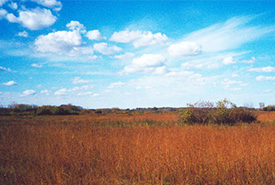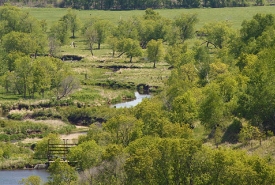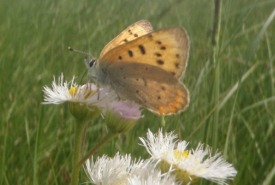The science behind conservation: Behind the scenes with the Manitoba Region’s Scientific Advisory Network

Giant hyssop, tall grass prairie, Manitoba (Photo by NCC)
Over a decade ago, a colleague contacted me to see if I would be interested in serving on a new science committee of the Nature Conservancy of Canada’s (NCC’s) Manitoba Region. As an ecologist working in the province for many years, I had heard of the great conservation work of NCC, and so I was keen to participate. I learned that the main functions of this Scientific Advisory Network (SAN) was to review and contribute ecological data to property proposals and conservation-area plans that were drafted by staff, and to forward recommendations on these to the Manitoba Board. By the second meeting I was asked to become the SAN Chair, and then soon after learned that this position automatically placed me as a full member of the Manitoba Regional Board. Suddenly I found myself on two NCC committees that met on a regular basis. Obviously this was an organization that could recruit volunteers and act effectively in pursuit of its goals.

Fort Ellice, MB (Photo by NCC)
Over the years our team has consisted of about six members (whose selection is approved by the Board) with a wide range of ecological expertise — essential for the critical review of diverse properties and area plans. Our focus is on the ecology and status of plants, birds, mammals and aquatic biology, but we are also knowledgeable about other types of organisms and environmental issues. Individuals (including both employed or retired) have been drawn from local universities, museums, Manitoba Conservation and Fisheries and Oceans Canada. We are also free to contact other scientists in related fields to help us arrive at decisions, making the process a true network.
With the coordinating support of an NCC conservation staff member in Manitoba (originally Gene Fortney and currently Cary Hamel), the Manitoba SAN has reviewed well over 200 property proposals, resulting in the conservation of 60,000 acres (24,300 hectares) through purchase, conservation easement and donation. This ensures that each proposal is suitable ecologically and that finances are in place for acquisition and stewardship. The SAN members are frequently asked a stewardship questions at meetings and their insight assists staff in planning appropriate site management activities.
Without a doubt, the most enjoyable activity for SAN members (and participating Board members as well) is the annual field trip to inventory the biodiversity and presence of rare species on several recently acquired NCC properties in Manitoba. Known as a bioblitz, participants observe and take samples of as many species as possible. This information is then incorporated by staff into stewardship plans and reports, and then shared with the Manitoba Conservation Data Centre. Determining an inventory of species present and their ecological requirements is important when deciding how to manage habitats and species far into the future.

Purplish copper butterfly, MB (Photo by NCC)
This spring, our inventory team of several staff, SAN and a Board member visited five properties and wildlife management areas in extreme southwestern Manitoba. It was an exhilarating experience being out in such beautiful rolling hills of native grassland and sharing the excitement of each other’s discoveries. I concentrated on insects and spiders and collected well over 125 species, which now await preparation, identification and future donation to an entomological museum.
A recent development by NCC in Manitoba has been a new program of financial and logistical support for research projects that help answer specific questions about biodiversity conservation and stewardship of NCC properties. A list of research projects is generated by staff and distributed to potential outside researchers, mainly university professors and their students. SAN members assist by suggesting and reviewing project proposals, by making sure the list reaches appropriate individuals and by reviewing submitted project applications. Usually these projects involve a number of conservation-minded organizations. Such cooperation thus opens many opportunities for research studies and education on NCC lands.
The Nature Conservancy of Canada is the largest and most influential wildlife and ecosystem conservation organization in the nation, with a remarkable record of conserving habitat in perpetuity for the benefit of wildlife, research, public education and environmental protection. In view of such worthwhile goals and achievements, it is no wonder that scientists and naturalists are willing to volunteer their time and expertise to the Scientific Advisory Network in Manitoba and those in other regional offices across Canada.


